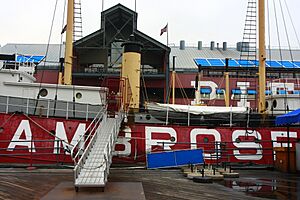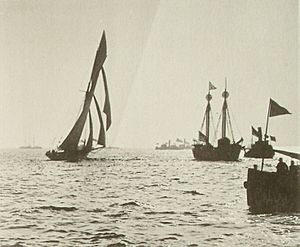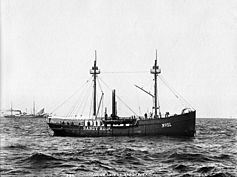Lightship Ambrose facts for kids

The Lightship Ambrose is actually the name for several special ships. These ships acted like floating lighthouses. They helped guide other ships safely into New York Harbor through the Ambrose Channel. This channel is the main path for big ships entering New York.
The very first light station in this area was set up in 1823 near Sandy Hook, New Jersey. From 1823 to 1967, many different ships served this important spot. Each one was called Lightship Ambrose. Their names were painted on their sides. In 1906, the lightship moved closer to the middle of the Ambrose Channel. Finally, on August 24, 1967, a big structure called a Texas Tower replaced the last lightship. This new structure was named the Ambrose Light.
Contents
Lightship LV-16: The Sandy Hook Sailboat

One of the first lightships was a sailboat named Sandy Hook. It was built from strong white oak wood. This ship helped mark the southern edge of the Ambrose Channel for 37 years, from 1854 to 1891. In 1862, it was given the number 16, so it became known as LV-16.
The Sandy Hook had two lanterns. Each lantern held eight oil lamps with reflectors to make the light brighter. For foggy weather, it had a bell that was rung by hand. In 1872, a new fog signal was added, but it didn't work well and was removed. This ship was involved in two crashes. One was in 1874 with a steamboat called Charleston. The second was in 1888 with a British ship called Star of the East.
Lightship LV-51: The First Steel Ship
The next lightship, Sandy Hook (LV-51), was built in 1892. It served the station from 1894 to 1908. In 1907, it was renamed Ambrose Lightship. Sometimes, pilots would even deliver mail to the crew on this ship.
This steamship was very special. It was the first U.S. lightship to have a full steel hull. It was also the first to use electric lights instead of oil lamps. After 1908, it was moved to a different job, helping out when other lightships needed repairs. On April 24, 1919, a barge crashed into it. The company that owned the barge, Standard Oil, had to pay for a new lightship because of the accident.
Lightship LV-87: The Radio Beacon Pioneer
The Lightship Ambrose (LV87) was built in 1908. It worked at the Ambrose Channel station until 1932. After that, it was moved to a different station called Scotland, which was closer to Sandy Hook.
This ship was the first lightship to be placed closer to the center of the channel. In 1921, it received the first radio beacon in the United States. This new technology helped ships navigate the busy channel much better, especially in thick fog. It was also the last steam-powered ship to work at this station. Even though it moved to different stations, it kept the famous name Ambrose.
In 1964, the United States Coast Guard stopped using it. In 1968, it was given to the South Street Seaport Museum in New York City. You can visit it today at Pier 16 on the East River. In 1989, it was recognized as a National Historic Landmark, which means it's a very important historical place.
Lightship LV-111: The Diesel Era Begins
The Lightship LV-111 served the Ambrose Channel from 1932 to 1952. This period included all of World War II. It was the first diesel-powered ship to mark the Ambrose Channel. Even though it was active during the war, it never had weapons. However, it did get a radar system in 1945.
This ship was involved in several crashes. In September 1935, a ship called Santa Barbara hit it, causing a lot of damage to both vessels. In January 1950, an unknown ship brushed against it in heavy fog. This damaged its radio antenna and it lost a spare anchor. Just eleven weeks later, in March 1950, another ship, Santa Monica, crashed into Ambrose in dense fog, tearing a hole in its hull. It was later fixed and moved to Portland, Maine. The ship was retired in 1969 and eventually sold for scrap in 1984.
Lightship WLV-613: The Last Ambrose Lightship
In 1952, the Lightship Ambrose (WLV-613) began its service. It was the very last lightship to mark the Ambrose Channel. On August 24, 1967, a Texas Tower lightstation replaced it.
After leaving the Ambrose Channel, it became a relief ship. It helped out along the Massachusetts coastline from 1967 to 1975. It was renamed Relief and then Nantucket II. Later, it worked at Nantucket Shoals, taking turns with its sister ship, the Lightship Nantucket (WLV-612). They would relieve each other about every 21 days. This ship retired in 1983 after 31 years of service.
After its retirement, WLV-613 had many different jobs. It was used for public events and even law enforcement missions. It was sold in 1984 and was present for the rededication ceremony of the Statue of Liberty in 1986. By 2006, it was owned by the Wareham Steamship Corporation and docked in Wareham, Massachusetts.



